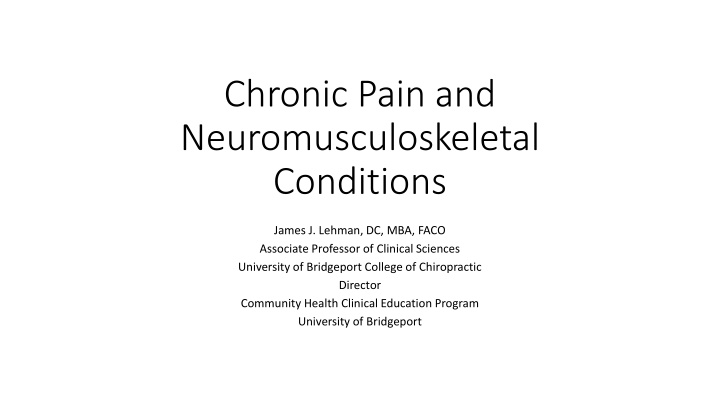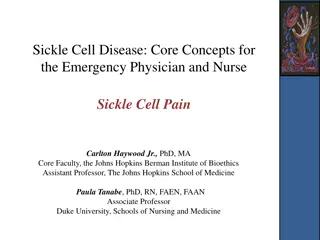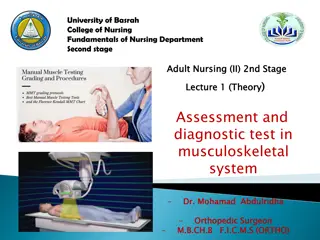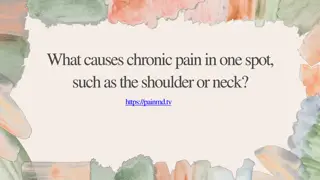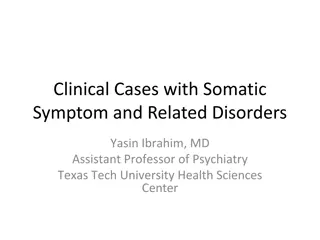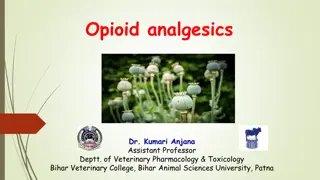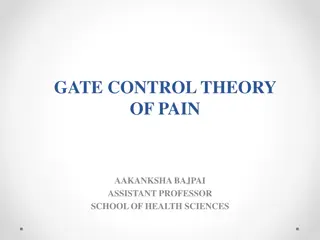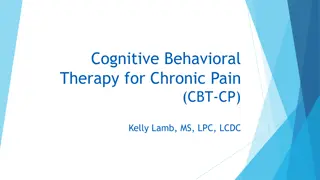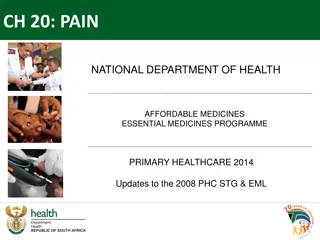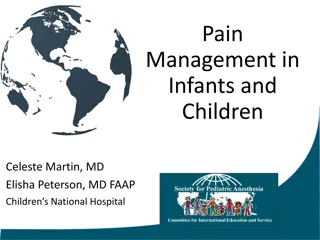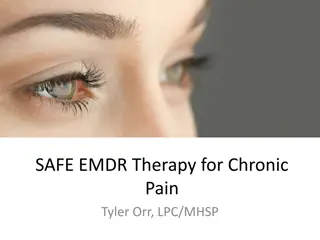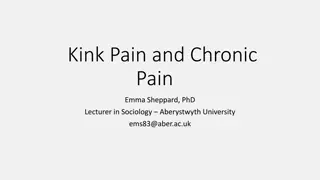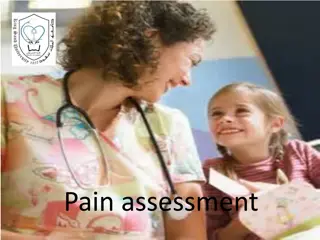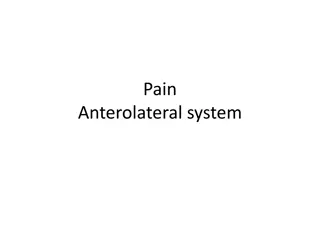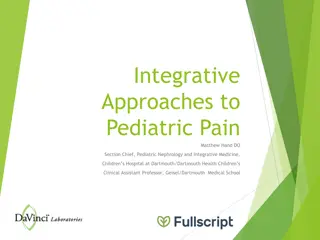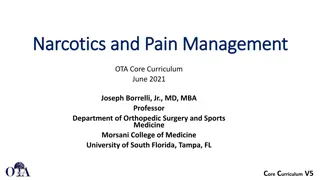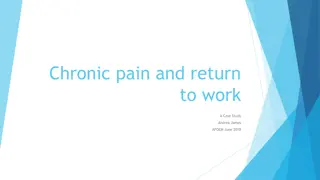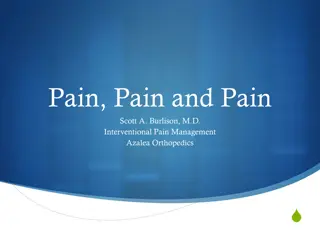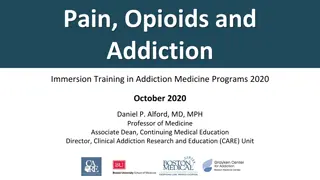Chronic Pain: A Comprehensive Overview
Chronic pain and neuromusculoskeletal conditions are prevalent health issues that require a specialized approach for accurate diagnosis and treatment. This content delves into learning objectives, national pain strategies, and the significance of addressing persistent pain as a chronic illness that can greatly impact individuals, families, and healthcare systems. A call to revolutionize chronic pain care emphasizes the need for prompt and effective management to alleviate the burden of pain-related disability and enhance overall quality of life.
Download Presentation

Please find below an Image/Link to download the presentation.
The content on the website is provided AS IS for your information and personal use only. It may not be sold, licensed, or shared on other websites without obtaining consent from the author.If you encounter any issues during the download, it is possible that the publisher has removed the file from their server.
You are allowed to download the files provided on this website for personal or commercial use, subject to the condition that they are used lawfully. All files are the property of their respective owners.
The content on the website is provided AS IS for your information and personal use only. It may not be sold, licensed, or shared on other websites without obtaining consent from the author.
E N D
Presentation Transcript
Chronic Pain and Neuromusculoskeletal Conditions James J. Lehman, DC, MBA, FACO Associate Professor of Clinical Sciences University of Bridgeport College of Chiropractic Director Community Health Clinical Education Program University of Bridgeport
Learning Objectives Correlate anatomy and the patients signs and symptoms in order to locate the neuromusculoskeletal lesion(s) and properly record the findings. Approach each patient s health problem with the concern of a neuromusculoskeletal medicine specialist. Chart orthopedic and neurological examination findings with a SOAP process in order to perform a differential diagnosis and create a working diagnosis of chronic pain syndrome. Provide high quality, patient-centered, neuromusculoskeletal medicine for patients suffering with acute and chronic pain.
Active Learning Task Please report your definition of Chronic Pain Have you treated patients in the past month with chronic pain? Have you cured patients of chronic pain? Did you list the diagnosis of chronic pain in your chart and report it on the third party reimbursement form?
National Pain Strategy Chronic pain - Pain that occurs on at least half the days for six months or more.
Persistent Pain: A Chronic Illness Acute pain usually goes away after an injury or illness resolves. But when pain persists for months or even years, long after whatever started the pain has gone or because the injury continues, it becomes a chronic condition and illness in its own right. A Call to Revolutionize Chronic Pain Care in America: An Opportunity in Health Care Reform. The Mayday Fund. November 4, 2009. Amended March 4, 2010.
Persistent Pain: A Chronic Illness This chronic illness of pain, if inadequately treated, can impede the lives of individuals and families and produce a huge burden in health care over- utilization, lost work productivity and rising costs of pain-related disability. A Call to Revolutionize Chronic Pain Care in America: An Opportunity in Health Care Reform. The Mayday Fund. November 4, 2009. Amended March 4, 2010.
Persistent Pain: A Chronic Illness Prompt effective treatment of acute pain is critical. If pain becomes persistent, it must be effectively managed as a chronic illness not only to limit long- term human suffering but also to prevent lost productivity within our society. A Call to Revolutionize Chronic Pain Care in America: An Opportunity in Health Care Reform. The Mayday Fund. November 4, 2009. Amended March 4, 2010.
Chronic Pain is a Public Health Problem Chronic pain commonly defined as pain persisting longer than six months affects an estimated 70 million Americans and is a tragically overlooked public health problem. U.S. Department of Health and Human Services. Health, United States, 2006. With chartbook on trends in the health of Americans [Internet]. Hyattsville, MD: National Center for Health Statistics [cited 2 009 Sept 4]. Available from: http://www.cdc.gov/nchs/data/hus/hus06.pdf.
Pain that extends beyond the expected period of healing. Turk, D.C.; Okifuji, A. (2001). "Pain terms and taxonomies". In Loeser, D.; Butler, S. H.; Chapman, J.J. et al. Bonica's management of pain (3 ed.). Lippincott Williams & Wilkins. pp. 18 25.
The burden of chronic pain is greater than that of diabetes, heart disease and cancer combined. Data on specific disease burdens is available from the Center for disease Control and Prevention s FastStats website available from: http://www.cdc.gov/nchs/fastats/. The burden of pain is available from: http://www.cdc.gov/nchs/data/hus/hus06.pdf
Chronic Pain is a Public Health Problem Poorly assessed, unrelieved chronic pain can rob individuals and family members of a high quality of life, and it profoundly burdens society as a whole. A 1998 National Institutes of Health (NIH) report concluded that just the economic toll of chronic pain may be estimated at $100 billion a year in the United States. It has increased significantly since then National Institutes of Health [Internet]. NIH guide: new directions in pain research: I. Bethesda, MD: National Institutes of Health. 1998 Sept 4 [cited on 2009 July 30]. Available from:http://grants.nih.gov/grants/guide/pa-files/PA-98-102.html.
Reasons for Chiropractic Orthopedists with Subspecialty in Neuromusculoskeletal Medicine Most people in pain, including those with chronic symptoms, go to primary care providers to get relief. But current systems of care do not adequately train or support internists, family physicians and pediatricians, the other health care providers who provide primary care in meeting the challenge of treating pain as a chronic illness. Primary care providers often receive little training in the assessment and treatment of complex chronic pain conditions. American Pain Foundation [Internet]. Pain resource guide: getting the help you need. 2009 June [cited on 2009 July 30]; pg 2. Available from: http://www.painfoundation.org/learn/publications/files/PainResourceGuide2009.pdf.
Reasons for Chiropractic Orthopedists with Subspecialty in Neuromusculoskeletal Medicine Instead of receiving effective relief, patients with persistent pain often find themselves in an endless cycle, seeing multiple health care providers, including many specialists in areas other than pain, who are not prepared to respond effectively. American Pain Foundation [Internet]. Pain resource guide: getting the help you need. 2009 June [cited on 2009 July 30]; pg 2. Available from: http://www.painfoundation.org/learn/publications/files/PainResourceGuide2009.pdf
Reasons for Chiropractic Orthopedists with Subspecialty in Neuromusculoskeletal Medicine They often endure repeated tests and inadequate or unproven treatments. This may include unnecessary surgeries, injections or procedures that have no long-term impact on comfort and function. Patients with chronic pain have more hospital admissions, longer hospital stays, and unnecessary trips to the emergency department. Such inefficient and even wasteful treatment for pain is contributing to the rapid rise in health care costs in the United States. American Pain Foundation [Internet]. Pain resource guide: getting the help you need. 2009 June [cited on 2009 July 30]; pg 2. Available from: http://www.painfoundation.org/learn/publications/files/PainResourceGuide2009.pdf
Reasons for Chiropractic Orthopedists with Subspecialty in Neuromusculoskeletal Medicine Adults aren t the only ones who suffer (with chronic pain). An estimated 20 percent of children experience chronic pain and millions do not receive effective pain relief. Children in pain often bounce from doctor to doctor. If they do not get the appropriate treatment they are at risk of developing a pain condition that might remain into adulthood. Jones GT, Power C, Macfarlane GJ. Adverse events in childhood and chronic widespread pain in adult life: results from the 1958 British birth cohort study. Pain 2009; 143(1-2):92-96.
Reasons for Chiropractic Orthopedists with Subspecialty in Neuromusculoskeletal Medicine Ideally, all patients with pain should obtain an appropriate assessment followed by a plan of care that reflects best practices, to prevent the adverse effects of that pain both in the short term and over time. Patients with chronic pain should receive a model of care that matches their need, is safe, appropriate, cost - effective, and guided by scientific evidence. They should also have access to a comprehensive approach, with a referral to pain specialists, when necessary. A Call to Revolutionize Chronic Pain Care in America: An Opportunity in Health Care Reform. The Mayday Fund. November 4, 2009.Amended March 4, 2010.
Sir William Osler Perhaps Osler's greatest contribution to medicine was to insist that students learn from seeing and talking to patients and the establishment of the medical residency.
Learning Task Form groups of four Select a spokesperson Create a putative case report with subjective and objective findings for a patient presenting with post-traumatic chronic pain and cervicogenic headaches (20 minutes) Determine an appropriate evaluation and management program for this patient Present your report of findings with recommendations (2 minutes each)
Strategies for Evaluating the Patient with Chronic Pain W. Clay Jackson, MD The Pain Practitioner Spring 2014
Evaluation of a Chronic Pain Patient A comprehensive evaluation of the patient with chronic pain is rarely straightforward and it begins with the recognition that a complete cure is unlikely.
Complications The patient s pain experience may be complicated by numerous factors, including lack of an obvious pathological cause, concomitant anxiety and depression, and a downward spiral of inactivity and lowered self-esteem
Medication Side Effects Often medications used to treat the pain may themselves cause side effects that contribute to the patient s reduced function.
Modalities The skillful clinician will work with the patient, incorporating time-efficient tools to determine a treatment plan that combines a variety of modalities and may or may not include the use of opioids.
Mutual Frustrations With chronic pain patients, the evaluation is key: Failure to identify all the factors that contribute to the pain can lead to ineffective treatment, further deterioration, and mutual frustration, not to mention legal and regulatory consequences.
Validation of Pain A seasoned clinician listens carefully to validate the patient s pain without allowing elaborate descriptions to derail the timing and purpose of the visit.
Goal of Treatment For most patients with persistent pain, the goal of treatment is not complete relief of pain, but rather improvements in the patient s physical and mental functioning that result in an improved quality of life as he or she takes increasing responsibility in his or her own therapy.
Outcomes Patient and clinician may be traveling a long and bumpy road, but the outcome can be meaningful and beneficial for both.
Assessment Process Evaluate and document the patient s pain history including the nature, location, intensity, and duration of the pain; current and prior pharmacological and non-pharmacological treatments; factors that worsen or improve the pain; underlying or coexisting conditions; and (importantly) the effect of the pain on the patient s life.
Assessment Process An assessment of function should include the impact of the pain on the patient s family and social life, employment, and sleep, and provide a baseline for follow-up evaluations.
Assessment Process The clinician should also be alert to signs that the patient is minimizing or maximizing the subjective reports of the pain or, in cases of cognitive impairment, lacks the proper resources to describe it.
Sir William Osler It is more important to consider what kind of patient has the disease, rather than what kind of disease the patient has
Sir William Osler "He who studies medicine without books sails an uncharted sea, but he who studies medicine without patients does not go to sea at all."
Sir William Osler The contribution to medical education of which he was proudest was his idea of clinical clerkship having third- and fourth-year students work with patients on the wards. He pioneered the practice of bedside teaching, making rounds with a handful of students, demonstrating what one student referred to as his method of "incomparably thorough physical examination."
Assessment Process Include questions regarding depression, anxiety, PTSD, and other factors that might impact pain, including stress levels at home or at work.
Assessment Process Consider the patient s capacity for chemical coping, or likelihood of using pain medication to cope with life s stresses.
Assessment Process any evaluation that may lead to a trial of opioids should include an assessment of the patient s risk for opioid misuse, but it also should include a qualitative assessment of the patient s goals.
Assessment Process What are the patient s functional goals? How does the patient define functionality? What are simple, concrete things the patient wants to do in the next 30 days? How can treatment help the patient reach her goals?
Assessment Process Attempt to ascertain whether the pain is a part of the history or consumes the history.
Assessment Process Which medications has the patient tried: NSAIDs Serotonin norepinepherinine reuptake inhibitors (SNRIs) Nerve cell membrane stabilizers (anticonvulsants) And/or opioids
Assessment Process Perform a focused physical examination based upon the patient s history and carry out appropriate diagnostic testing.
Treatment Considerations The patient-clinician relationship is best viewed as a collaborative partnership; whereas patient demand should not determine the choice of a therapy, it should inform the choice.
Treatment Considerations Many patients want to combine complementary and alternative medicine options with pharmacological therapy, and the assessment will help determine which therapy will provide greatest benefit.
Case 1 Subjective data: 40 year-old female with pain in tailbone with sitting since falling on ice five (5) years earlier. Physical therapy and chiropractic manipulation of the pelvis, lumbosacral and sacroiliac joints did not provide relief. She has been advised to undergo coccygectomy to relieve pain.
Case 1 What type of examination procedures would your perform?
Case 1 Record your examination and putative objective data, assessment and plan.
Case 1 Assessment (Diagnoses): 1. Post-traumatic chronic pain syndrome, ICD 10: G89.21 2. Coccygodynia, ICD 10: M53.3
Coccygodynia The term 'coccygodynia' means the pain is in the tailbone area (os coccygis; coccyx).
